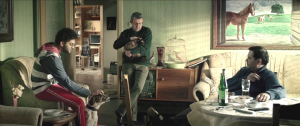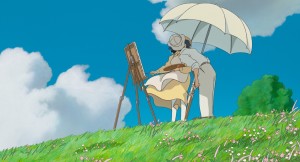Jimbo’s Top 20 Films Screened in Madison in 2014
With a few caveats, cheats, honorable mentions, and home video links
As we all know, lists are silly. And it is particularly silly for me to suggest the Top 20 films of 2014, if only because I haven’t seen everything. Based on lists already out there in Madison alone, clearly I should have seen Blue Ruin, Force Majeure, The Immigrant, and The Guest if I want to be taken seriously. For a list like this to have some significance, I would need to see all the bad stuff, too. Without that breadth, I feel like a cherry-picker. Beyond that, this also might be silly because not everything comes to Madison (which makes me all the more envious reading John Waters’s list at Artforum, among others). And I probably should have written something about all 20 of these films before now, right? Well, I promise to do my best to address some of those issues in 2015 (see more, write more) so that my next year end list carries more weight.
Meanwhile, with those issues and limitations in mind, below are some films I enjoyed quite a bit this year. Each of them surprised me in some way, which I’ll discuss in the brief comments for each title rather than provide plot synopses (which can be found at many of the links provided with each title).
I’m limiting myself to films that played at least once for a public screening in Madison, including the Wisconsin Film Festival, even if I actually saw the film by other means (preview screener, or home video later in the year). I was tempted to bend that rule a bit to include The Babadook, but I’ll just wait a little bit longer for WUD Film to bring it to the Marquee Theater. I decided to cheat by including “ties” between films that are related (at #13 and #14), but obviously this is just a ruse to put 22 films on the list. I don’t know if any film here is objectively better than another one, but I can honestly say that I liked a given film more than another film, which guided the order of my list.
Links are current as of the publication date. For future updates about streaming and DVD availablity, click the GoWatchIt links and put titles in your queue. Be sure to check out Jake Smith’s list in “Jake’s Take: 2014 in Review.”
 1. Under the Skin | Jonathan Glazer | UK | 2013 | 108 min
1. Under the Skin | Jonathan Glazer | UK | 2013 | 108 min
Amazon Instant | Netflix | GoWatchIt | Four Star | Madison Public Library
This is not the film I put at the top of the list during early drafts, but it kept moving up as I thought about film experiences in relation to each other in 2014. Despite the prominence of science fiction as a popular genre, one might forget that sci-fi shrouded in mystery and ambiguity can have a unique cinematic power. Jonathan Glazer somehow manages to get us to root for an alien who is doing manipulative and ultimately horrible things in order to survive (okay, it helps that some of the victims are “players” who are just trying to get laid). But when “The Female” (Scarlette Johannson) begins to question her own methods (and existence), the horror becomes shaded with angst. Johannson reminds us here that she has a range that isn’t always utilized in her Hollywood blockbusters. And finally what really places it above the rest is one of the most memorable and most disturbing special effect shot of the year.
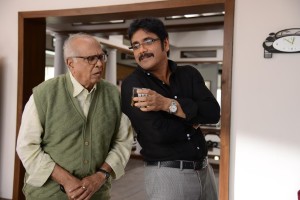 2. Manam | Vikram Kumar | India | 2014 | 163 min
2. Manam | Vikram Kumar | India | 2014 | 163 min
Amazon Instant | Netflix | GoWatchIt | Four Star | Madison Public Library
We’ve done our best here at the Madison Film Forum to highlight Indian popular cinema playing in Madison, mostly at AMC Star 18 Fitchburg (and occasionally at Marcus Eastgate). I certainly had a lot of fun watching Bollywood films (from the Hindi-language Indian film industry) and I’ve included a few Bollywood titles in the Honorable Mentions below. But my favorite example of Indian popular cinema was actually a Telugu-language (or “Tollywood” industry) film starring three generations of the Akkineni family, including the final screen role of 90-year old legendary star Akkineni Nageswara Rao, who passed away before the film was released. The premise of the film involves absurdly complicated layers of reincarnations and reunions, but the execution is a perfect blend of broad comedy, grand romance, and heartfelt family melodrama. Without a doubt, Manam was the most shamelessly entertaining film I saw in 2014. It also has the most surprising (and funniest) series of face slaps punctuated by freeze frames that I’ve ever seen.
 3. Goodbye to Language | Jean-Luc Godard | France | 2014 | 70 min
3. Goodbye to Language | Jean-Luc Godard | France | 2014 | 70 min
Amazon Instant | Netflix | GoWatchIt | Four Star | Madison Public Library
This places high on the 2014 list not only for the film itself, but also for the quality of the screening, which was a benefit for the UW-Cinematheque held at Marcus Point to raise funds for campus 3D projection equipment. The screening exemplified what the UW campus film organizations can do better than anyone else when they want to: bring in truly unique screenings of the best of international cinema, and provide contextual guidance for those who might be exploring more difficult material for the first time. In this case, retired professor David Bordwell (who was instrumental in securing the film for the screening in the first place) provided extremely helpful introductory remarks and led a fruitful discussion session afterwards. You knew that this was worth going to when so many black-clad cineastes from Milwaukee and Chicago made the drive to Madison to see it. The film itself was, as expected, somewhat obtuse, and certainly will benefit from multiple viewings (which I’m working on now that I have a 2D copy). As Bordwell pointed out, Godard continues to experiment with how minimally he can suggest a plot and still maintain a narrative, while continuing to foreground the material production of the image. But Goodbye to Language was far and away the most interesting visual experience of 2014, with Godard thinking way outside of the 3D box. My favorite shot: a woman screen left is talking to a man screen right. The man walks off screen right. The “left eye” camera remains on the woman, but the “right eye” camera pans right to follow the man. Your brain is not capable of processing this, and I only realized what was going on by closing one eye and then the other. It’s not often that I can say that I’ve never seen something in a movie theater before; that shot certainly qualifies.
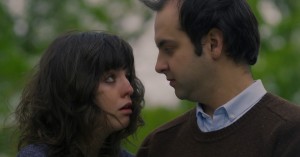 4. Crimes Against Humanity | Jerzy Rose | USA | 2014 | 77 min
4. Crimes Against Humanity | Jerzy Rose | USA | 2014 | 77 min
Amazon Instant | Netflix | GoWatchIt | Four Star | Madison Public Library | Fandor
While I didn’t numerically rank my favorite films at the 2014 Wisconsin Film Festival, now that I’m ranking this year-end list I realize that Crimes Against Humanity was indeed my favorite. It’s a great absurdist comedy about how horrible people can be to themselves and to others, especially in romantic relationships. And again, in a year that I valued surprises, director Jerzy Rose provides many comic surprises throughout the film, some of them genuinely silly. My favorite scene was a cameo by Chicago-based animator Chris Sullivan as a role-playing policeman who turns a routine roadside inquiry into a impromptu improv class. I did not follow up on my promise to write more about Crimes Against Humanity because I knew it would be difficult for readers to catch up with it. But its recent inclusion at Fandor (along with some earlier Jerzy Rose films I hope to catch up with) has convinced me to finally subscribe to Fandor. I will write more about Crimes (and other Fandor offerings) in 2015.
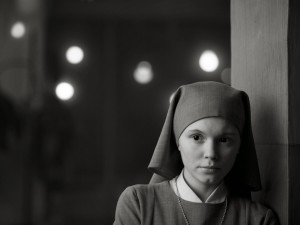 5. Ida | Pawel Pawlikowski | Poland | 2013 | 80 min
5. Ida | Pawel Pawlikowski | Poland | 2013 | 80 min
Amazon Instant | Netflix | GoWatchIt | Four Star | Madison Public Library
Ida has a lot of things going for it, and it is no surprise that it has ended up on many Top Ten lists this year. Visually, it is subtle yet stunning with its unbalanced compositions (in Academy ratio) and black-and-white cinematography. Dramatically, it is quietly heartbreaking as we follow a novice nun Ida (Agata Trzebuchowska), who is instructed to contact her sole known relative before she takes her vows. Her Aunt Wanda (Agata Kulesza), however, has been mysteriously reluctant to have any contact with Ida or the convent before now. Eventually Ida and Wanda agree to take a painful journey into the history and legacy of World War II and post-war Poland. Ida successfully explores some grand themes ranging from the nature of faith and spirituality to survivor’s guilt by focusing on a specific family’s personal history and pain. The film also features one of the year’s most memorable static long takes, the simplicity of which is inversely proportional to its dramatic and emotional impact.
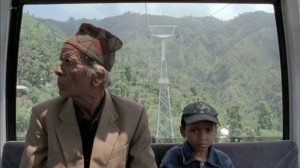 6. Manakamana | Stephanie Spray, Pacho Velez | USA | 118 min
6. Manakamana | Stephanie Spray, Pacho Velez | USA | 118 min
Amazon Instant | Netflix | GoWatchIt | Four Star | Madison Public Library
Speaking of long takes, part two. No other film more audaciously exploits the power of the long take than Manakamana, the one-of-a-kind documentary from Harvard’s Sensory Ethnography Lab, the team that produced the fishing vessel epic, Leviathan (2012). The static camera simply documents pilgrims on a cable car travelling to and from the Manakamana temple in Nepal. Each shot is a one-way trip of 8.5 minutes, and we share 11 such rides with pilgrims of various ages and backgrounds. In addition to many Warholian complexities and pleasures of gesture and expression within each shot, the conversations among the pilgrims begin to resonate with each other across the course of the film (we recall early discussions of air conditioning when later pilgrims comically attempt to eat ice cream cones, which are not allowed during the trip). This is an all or nothing experience; either you’re all in and fully engaged with every detail, or you’re completely bored. But that boredom would be your choice, not the fault of the filmmakers. The pleasant surprise here was that most of the audience I saw it with were willing and able to take the journey with the film and remain fully engaged, which made it a great screening experience. (Follow the link to my first thoughts about Manakamana on Day One of the Wisconsin Film Festival.)
7. Domestic | Adrian Sitaru | Romania | 2013 | 85 min
Amazon Instant | Netflix | GoWatchIt | Four Star | Madison Public Library | Seed&Spark
Speaking of long takes, part three. I had the good fortune of having time to examine and write at length about Domestic before the Wisconsin Film Festival. As I wrote in March, the long takes in Domestic are fascinating because they don’t immediately give you all the information you need to understand what is going on. Through the repetition and variation of certain details and motifs, what on the surface level appears to be a quirky portrait of eccentric neighbors and their pets slowly transforms into a meditation on death, loss, grief, and regret. Sitaru has clearly learned long take lessons from his Romanian colleagues Cristi Puiu (The Death of Mr. Lazarescu), Cristian Mungiu (Beyond the Hills), and Corneliu Porumboiu (I should admit here that I missed When Evening Falls on Bucharest at WFF 2014) but with Domestic he finds his own voice by guiding us to notice what is left unsaid. When we understand what was not said about the last shot of the film, it becomes one of the most touching endings of 2014.
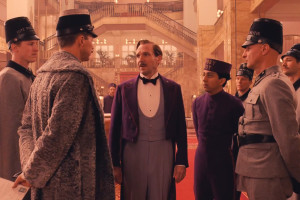 8. The Grand Budapest Hotel | Wes Anderson | USA | 2014 | 99 min
8. The Grand Budapest Hotel | Wes Anderson | USA | 2014 | 99 min
Amazon Instant | Netflix | GoWatchIt | Four Star | Madison Public Library
I didn’t like Anderson’s Moonrise Kingdom as much as many other people seemed to, so I went into The Grand Budapest Hotel with a mild case of Anderson fatigue. But I had a smile on my face during the entire film because Anderson’s hyper-stylized mise-en-scene was well suited to this material and was entertaining even on its own. It’s probably time we acknowledge, if we haven’t already, that Anderson is one of the most unique visual stylists working in mainstream American filmmaking today. Unlike most of his contemporaries, you can identify an Anderson shot almost immediately. I also felt the film achieved a better balance between authorial irony and genuine sentiment than some of Anderson’s more recent films. As broad as his character might be, Ralph Fiennes finds a way to balance Gustave’s self-importance with his genuine affection for and commitment to his lobby boy, Zero (Tony Revolori). The rest of Anderson’s stock cast, Adrien Brody, Willem Dafoe, Jeff Goldblum, Edward Norton, Bill Murray, Jason Schwartzman, Tilda Swinton, and Owen Wilson, all return to provide just the right comic tone. And the multi-layered flashback, which might seem like a gimmick in other films, here provides an extra sense of loss and regret for a time that we know never really existed as conveyed here, but we wish it had.
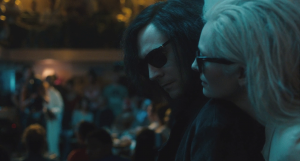 9. Only Lovers Left Alive | Jim Jarmusch | USA | 2013 | 123 min
9. Only Lovers Left Alive | Jim Jarmusch | USA | 2013 | 123 min
Amazon Instant | Netflix | GoWatchIt | Four Star | Madison Public Library
The biggest surprise with Only Lovers Left Alive was that after I had selected it for my first “Missed Madison” review, it actually played not once but twice in Madison (at MMoCa Spotlight Cinema and the WUD Mini-Indie Festival). As I wrote in September: In Only Lovers Left Alive, Jarmusch tips his hat to many vampire genre conventions while wandering through an idiosyncratic story structure that foregrounds many of his longtime preoccupations. That might not be enough for the zombies with short attention spans who cry out for brains, but the results are tasty for hipsters and aesthetes who don’t need to drink a movie dry, but can savor a fine glass of the good stuff. In retrospect, I also appreciated the film for its deliberate pace in an era when filmgoers seem to have ever decreasing attention spans (it was “slow” was the most common criticism I heard of the film). That deliberate pace allowed one to savor the textures of the image and the soundtrack. Let’s hope the next Jarmusch film actually gets a commercial release in Madison (if I’m not mistaken, this is the third in a row not to have one).
 10. Listen Up Philip | Alex Ross Perry | USA | 2014 | 108 min
10. Listen Up Philip | Alex Ross Perry | USA | 2014 | 108 min
Amazon Instant | Netflix | GoWatchIt | Four Star | Madison Public Library
That’s right, I’m ranking Listen Up Philip higher than Boyhood. But with both films I admired the filmmakers’ willingness to allow the protagonists to be occasional jerks. Well, in Listen Up Philip, Philip (Jason Schwartzman) isn’t just an occasional jerk, he’s a far more consistent jerk. Not unlike the humor in Crimes Against Humanity, which is rooted in the way we tend to mistreat each other, many of the laughs in Listen Up Philip flows from the sheer audacity of Philip’s inflated ego that masks his insecurities. Some of this stuff shouldn’t be funny, which is why it has turned off some audiences. In a post-screening discussion, one friend mentioned that it helped her figure out what was supposed to be funny, as opposed to just emotionally abusive, by hearing my laugh. However, the film would not have sustained interest if it had only maintained that overbearing tone for the entire running time. The pleasant surprise here was the section dedicated to Elisabeth Moss’s character Ashley, as she takes back control of her life after her relationship with Philip has ended (as far as she’s concerned). By shifting focus between Philip, Ashley and other supporting characters, Listen Up Philip develops into a well observed, emotionally rewarding dark comedy.
 11. Boyhood | Richard Linklater | USA | 2014 | 164 min
11. Boyhood | Richard Linklater | USA | 2014 | 164 min
Amazon Instant | Netflix | GoWatchIt | Four Star | Madison Public Library
As I suggested above, one of many things that I liked about Linklater’s 12-year project is that he had the courage to make the lead protagonist Mason (Ellar Coltrane) kind of a jerk when he hit his late teens, rather than maintain a 2 1/2 hour cutefest. A recent conversation with Madison Film Forum colleague Taylor Hanley reminded me that Boyhood has a lot of negative things to say about American manhood, and perhaps more should be said about all of the men in Mason’s life as his mother Olivia (Patricia Arquette) struggles through three failed marriages. But even when Mason hits his rocky “jerk” period, the film provides a unique emotional experience as we literally watch the character and the actor grow up before our eyes. The film is most successful when it makes quiet, small observations through well observed scene work, rather than paint with broad strokes of overarching themes and ideas. This provides Ethan Hawke the opportunity to do some great work in several individual scenes. And Arquette’s performance in the scene when Mason finally leaves home provides one of most memorable screen moments of 2014.
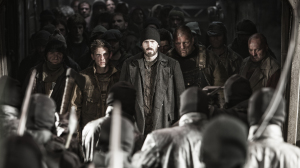 12. Snowpiercer | Bong Joon-ho | South Korea |2013 | 126 min
12. Snowpiercer | Bong Joon-ho | South Korea |2013 | 126 min
Amazon Instant | Netflix | GoWatchIt | Four Star | Madison Public Library
I believe the critical divide over Snowpiercer can be explained by the fact that critics on both sides are making similar observations about what they see, they just have different opinions about its merits. Specifically, many negative critics find the film an inconsistent mishmash of ideas with abrupt changes in tone. I would agree about the lack of unity and the abrupt shifts in tone, but that’s exactly what I found entertaining and even liberating. I was fully engaged as the rebels led by Curtis (Chris Evans) worked their way through the train, compartment by compartment, not only because each car presented a new dramatic obstacle, but also because each car could turn the film into something dramatically different. One car might have a relentlessly brutal action scene. Another car might have a genuinely loopy, surreal, satirical take on ideological indoctrination. Director Bong Joon-ho also seems to be having fun with the disparate elements that come together for any international co-production; the international audience requires English yet there’s still an important role for Song Kang-ho, who has worked with Bong on Memories of Murder (2002) and The Host (2006). In a year when some of the biggest film industry stories were the release schedules for Marvel and DC adaptations for the next several years, I believe that the best graphic novel adaptation was Snowpiercer. (I do, however, give Guardians of the Galaxy an honorable mention, below).
13a. Jodorowsky’s Dune | Frank Pavich | USA | 2013 | 90 min
Amazon Instant | Netflix | GoWatchIt | Four Star | Madison Public Library
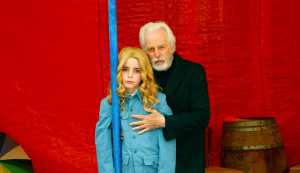 13b. The Dance of Reality | Alejandro Jodorowsky | France | 2013 | 130 min
13b. The Dance of Reality | Alejandro Jodorowsky | France | 2013 | 130 min
Amazon Instant | Netflix | GoWatchIt | Four Star | Madison Public Library
Okay, now I start cheating so that I can include 22 films in the list by thematically combining some entries. But in many ways it is hard to separate these two films in my mind, and even their production histories are related. Jodorowsky’s Dune is an example of a documentary with a can’t-lose scenario: an intriguing topic with a central subject who is spellbinding in front of the camera. While the film’s thesis about the unmade Dune‘s influence is somewhat overstated, there’s no doubt that the creative minds first brought together to attempt to make the film, including Dan O’Bannon and H.R. Geiger, have had a lasting impact on production design and art direction through their subsequent work on Ridley Scott’s Alien. But the real star of the show here is Jodorowsky, and one can’t help but repeatedly ask during the film, “Why isn’t he making films now?” Well, that question is answered at the end when Jodorowsky and his estranged producer Michel Seydoux reunite to produce a new film. That project turned out the be The Dance of Reality, which only played in Madison at the Wisconsin Film Festival. As I wrote in April, Jodorowsky is still a master of the concise, vivid, and wildly imaginative image, the best example here being the death of Jodorowsky’s grandfather, which is surprising, audacious, violent, funny, and beautiful. But Jodorowsky surprises us beyond the usual shock tactics with some genuine nostalgia. As young Alejandro (Jeremías Herskovits) looks out towards the sea, the older Alejandro (playing himself) guides his hands in a very simple series of dance-like movements. Jodorowsky’s voice over contemplates the fact that the younger and older selves can never truly know each other. It’s a lovely moment that broadens Jodoowsky’s filmmaking palette.
14a. The Wind Rises | Hayao Miyazaki | Japan | 2013 | 126 min
Amazon Instant | Netflix | GoWatchIt | Four Star | Madison Public Library
 14b. The Tale of the Princess Kaguya | Isao Takahata | Japan | 2013 | 137 min
14b. The Tale of the Princess Kaguya | Isao Takahata | Japan | 2013 | 137 min
Amazon Instant | Netflix | GoWatchIt | Four Star | Madison Public Library
Regardless of whether Studio Ghibli, arguably the most influential animation studio after Walt Disney Studios, continues beyond 2015, we all have known that Hayao Miyazaki and Isao Takahata have been closer to the end of their careers than the beginning for some time now. Miyazaki announced his retirement back in 2013, and Takahana will turn 80 years old in 2015. In 2013 the UW-Cinematheque took us on a very popular tour of Studio Ghibli’s output (I wrote about the Ghibli series in Isthmus), so we were very fortunate in 2014 to see both recent Ghibli (and final?) releases on the big screen. Miyazaki’sThe Wind Rises (which will return to the UW-Cinemtheque in January) was an emotionally and morally complicated drama about a airplane designer Jiro, who is torn between his technical and aesthetic ambitions for his fighter planes and the consequences of his work for the Japanese war effort. In Princess Kaguya, Takahata also gives us an emotionally complicated fairy tale, as a bamboo cutter finds an enchanted baby girl in a bamboo shoot, and decides that the gods want him to give her the life of a princess. Princess Kaguya (“light”) struggles between her vivacious enjoyment of life and her stuffy formal obligations as a princess, until she discovers the truth about her origins before her life on Earth. Beyond the intriguing narratives, of course, both films feature stunning visuals, both in quiet scenes and in bursts of spectacle. Miyazaki naturally returns to his favorite theme, flight, as a means to thrill us with several airborne sequences. But Takahata might have the upper hand here; the sequence where Princess Kaguya bursts away from her coming out party is one of the most exhilarating screen moments of 2014.
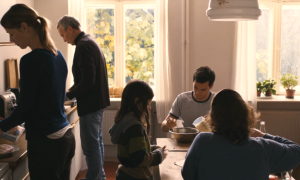 15. The Strange Little Cat | Ramon Zürcher | Germany | 2013 | 72 min
15. The Strange Little Cat | Ramon Zürcher | Germany | 2013 | 72 min
Amazon Instant | Netflix | GoWatchIt | Four Star | Madison Public Library | Fandor
Here’s my second reason for subscribing to Fandor in 2015; their keen eyes saw the value of The Strange Little Cat when they acquired at the Cannes Film Festival. Madison audiences were also fortunate for the keen eyes of Tom Yoshikami and Mike King, who brought the film to Madison for one screening at the Madison Museum of Contemporary Art’s Spotlight Cinema series. As I wrote in November, I can’t think of a more densely detailed short feature. Running only 72 minutes, it provides wonderfully insightful observations of three generations of a family as they go about their mundane tasks to prepare for an extended family dinner. Like Manakamana, it might seem like nothing is going on here, but there are many layers of salient details, in the mise-en-scene and in the dialogue, that begin to resonate with each other across the course of the film. A key character in the film is young Clara, who is just old enough to start writing, but not always quite old enough to understand what the adults are talking about. Sometimes we’re not exactly clear what is causing tension between some of the characters, so we’re not unlike young Clara observing with our best guesses as to what is going on under the surface. The Strange Little Cat is a great debut feature from Zürcher, and I look forward to more films from him in the future.
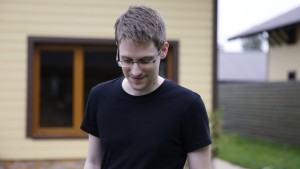 16. Citizenfour | Laura Poitras | USA | 2014 | 114 min
16. Citizenfour | Laura Poitras | USA | 2014 | 114 min
Amazon Instant | Netflix | GoWatchIt | Four Star | Madison Public Library
Like Jodorowsky’s Dune, filmmaker Laura Poitras has a can’t-lose situation here. She happened to be one of the journalists contacted by the then unknown (even to her) Edward Snowden, who claimed that as a contracted employee of the NSA, he had some important information about the government’s electronic surveillance that he felt compelled to leak to the public. Of course, anyone who has paid attention to the news now knows how big Snowden’s story became. So what we have with Citizenfour is a document of the leaking of documents, and the breaking of one of the most important stories in the post-September 11th era, a story whose consequences we will struggle with and argue about for years to come. Poitras expertly shapes this primary material into a suspense thriller, and even though we roughly know the story she generates a great deal of suspense. The heart of the film takes place in a series of hotel rooms in Hong Kong where Snowden finally agrees to meet in person with Poitras and her colleagues, which only adds to the sense of claustrophobia and (apparently justified) paranoia. Many of the small details here are quite chilling, like when Snowden chides The Guardian‘s Glenn Greenwald, who is more security conscious than most of us, for leaving the same SD card in his laptop for too long (a rookie mistake, apparently). I would have preferred a few more hardball questions directed at Snowden about his motivations or his understanding of the consequences of his actions. But regardless of your view of Snowden, his methods, or the issues he has raised, it is hard to deny that this story is compelling on both personal and political levels.
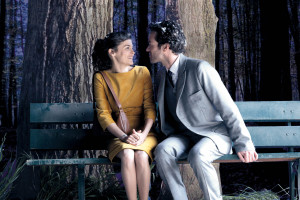 17. Mood Indigo | Michel Gondry | France | 2013 | 131 min
17. Mood Indigo | Michel Gondry | France | 2013 | 131 min
Amazon Instant | Netflix | GoWatchIt | Four Star | Madison Public Library
When the WUD Film Committee presented its last April edition of the Mini-Indie Festival, there remained too much post-Wisconsin Film Festival fatigue to truly appreciate their lineup. (Fortunately, the Mini-Indie Festival will subsequently be scheduled in the Fall, and their November edition fared far better, in my opinion). Lost in the shuffle in April, then, was Madison’s sole screening of the latest feature from Michel Gondry, Mood Indigo, an adaptation of Boris Vian’s surrealistic 1947 novel, L’Écume des jour. As I wrote in April, the novel provides Gondry with a fertile ground for his visual ideas, and without having to generate his own narrative material (like in the less successful Science of Sleep) Gondry is able to flourish. The film seemed like a free flowing series of ideas and associations, but I was surprised to find that many of the key plot elements (including the absurd ones like a water lily lung infection and the satirical ones like a character named “Jean-Sol Parte”) come directly from the original novel. The result is Gondry’s strongest film since Eternal Sunshine of the Spotless Mind, as he shifts from a playful, happy romance to a dark dystopia without removing the visually playful tone. That shift provokes an interesting emotional reaction as you continue to enjoy the visual playfulness as the tone becomes more bleak. Plus: you can’t beat Audrey Tautou in a charming gamine role. Here she stars as Chloé, who quickly transforms the life of protagonist Colin (Romain Duris); how could she not?
 18. We Are the Best! | Lukas Moodysson | Sweden | 2013 | 102 min
18. We Are the Best! | Lukas Moodysson | Sweden | 2013 | 102 min
Amazon Instant | Netflix | GoWatchIt | Four Star | Madison Public Library
If you follow our “Ephemera” link on our top menu, you will find some old documents including an issue of Madfilm, the newsletter of the earlier incarnation of the Madison Film Forum, from 1999. In it you’ll notice that the Forum sponsored a screening of Lukas Moodysson’s Show Me Love (also known by its better title, Fucking Åmål), a feature debut which helped Moodysson break through on the international film circuit. While Moodysson’s subsequent films have not been as successful, many people consider We Are the Best! a return to form. Both films focus on alienated young girls in Sweden, and in the case of We Are the Best! the girls decide to rebel against their situation by forming a punk band. As I wrote in September, Moodysson focuses on the three girls, Bobo (Mira Barkhammar), Klara (Mira Grosin) and Hedvig (Liv LeMoyne) and never suggests that the band is more important than their friendship. The result is an extremely entertaining film about their discovery that feeling like an outcast can be a source of strength when you’re with the right outcasts. Barkhammar, Grosin, and LeMoyne are such engaging performers that you really can’t fault Moodysson for occasionally turning them into mini-adults. The trio handle their scenes of tween-melodrama as well as they handle their scenes of giddy girl giggling. Barkhammar, in particular, gives Bobo a quiet, contemplative exterior with a tense anxiousness under the surface. Grosin provides just the right amount of hubris to Klara, who dominates the group despite not knowing as much as she thinks she does. I only wish there were more opportunities for LeMoyne to flesh out Hedvig’s significant transformation from a subdued classical guitarist to cussing and yelling on stage. All three actresses are perfect in the final scene in the bus ride home after the gig, simultaneously defiant, silly, playful, and empowered.
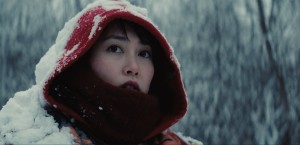 19. Kumiko, the Treasure Hunter | David Zellner | USA | 2014 | 105 min
19. Kumiko, the Treasure Hunter | David Zellner | USA | 2014 | 105 min
Amazon Instant | Netflix | GoWatchIt | Four Star | Madison Public Library
With Kumiko, the Treasure Hunter, the Zellner brothers (director/co-writer David, and co-writer Nathan) seem to be asking the question: How long will an audience remain sympathetic to a protagonist who makes a series of bad decisions in a quest that seems misguided in the first place? In the case of Kumiko, I was more than willing to follow Kumiko (Rinko Kikuchi) from Tokyo to the harsh winter landscape of Minnesota on her quest to find the lost money from the fictional Coen Brothers film Fargo, because her “based on a true story” adventure took me to a very different world that only seems to exist in great cinema. As I discussed in April, the film features many deceptively simple stylistic decisions that always seem to isolate Kumiko no matter what environment she finds herself in—we can always find her in her red hoodie. Besides her larger misguided Fargo plan, even her short term goals, from her scheme to liberate a map from the library or her plot to abandon her pet rabbit on a Tokyo train, are so odd that we start to infer that Kumiko must be living and operating within some kind of dream logic. The rabbit abandonment scene provokes multiple emotional responses because its simple staging is simultaneously funny, infuriating, and sad. Because of Kumiko’s commitment to her dream logic, the film begins to push the boundaries of verisimilitude, but in doing so it takes us somewhere we simply haven’t been before, even if the landscape looks familiar.
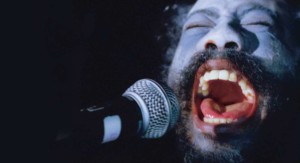 20. A Spell to Ward Off the Darkness | Ben Rivers and Ben Russell | UK | 94 min
20. A Spell to Ward Off the Darkness | Ben Rivers and Ben Russell | UK | 94 min
Amazon Instant | Netflix | GoWatchIt | Four Star | Madison Public Library | Fandor
I had a chance to write a capsule review for A Spell to Ward Off the Darkness in the Isthmus coverage of the 2014 Wisconsin Film Festival. Here’s a slightly longer version of that review.
“I think the mistake that is quite often made is that people give responsibility away when they are in [a] community.” That line, almost an aside in a brief conversation, resonated with me the most as I reflected on the experience A Spell to Ward Off the Darkness, an hybrid experimental documentary by Ben Rivers and Ben Russell. I offer it here as a possible starting point to think about the film because I want you to go see it but I don’t want you to read much more about it. I certainly discourage you from reading the complete description of the film in the Festival guide, which explicitly outlines the structure of the film. When an experimental film invites you to discover its structure in the course of viewing it, such an outline is worse than a narrative spoiler. So for now, simply start with the concept of “community,” then go to the screening and let the images and sounds happen.
The challenge for most viewers will be stylistic audacity of the final third of the film, though it might be easier for those familiar with musician Robert AA Lowe. Very quickly audience members will start asking themselves, “Is this what the last 20 minutes are going to be?” Spoiler: the answer is yes. As people discover this answer, there will be walkouts, but the good kind–the kind that leaves you at the end of the screening with fellow travellers. This is one of the few films I’ve previewed that I hope to watch again with an audience, if the projectionist agrees to play it loud.
My biggest regret of 2014: I didn’t make it to that screening. But I am very pleased to see that the film is available at Fandor.
Honorable Mentions:
Best Shorts Programs: Bursting at the Seams: Avant-Garde Restorations (UW-Cinematheque, January 31) | Rat Pack Rat: Todd Rohal Selects (Wisconsin Film Festival, April 7)
Sometimes shorts programs tell us where the cinema is headed. These great shorts programs, curated by Academy Film Archive’s Marc Toscano and filmmaker Tod Rohal, respectively, reminded us where we’ve been and how we got here.
Bollywood I’ll See Again If Anyone Asks: Bang Bang! | Happy New Year | PK
I’m serious. Let’s go. Meanwhile, you can now stream Happy New Year (which narrowly missed my list but made Jake’s list) directly from the film’s website (with a credit card, of course) as part of their “direct-to-fans” distribution model.
Best Hollywood Blockbuster: Guardians of the Galaxy
Great enough to make me less enthusiastic about almost every other Marvel or DC franchise. My enthusiasm might be influenced by repetitive exposure to the Awesome Mix Vol. 1 soundtrack.
Best NSFW: Nymphomaniac, Volume 1 | Nymphomaniac, Volume 2 | Wetlands
Everybody needs a date night every once in a while, right? But seriously, I admired both of these films and appreciated the willingness on the part of the filmmakers and actors to push boundaries to explore aspects of human experience that some of us would prefer not to think about, let alone discuss.
Best Get at WUD Mini-Indie Fest: What We Do in the Shadows
The cool kids at WUD Film really stepped up their game with the latest Mini-Indie Fest with a strong schedule overall. But getting such an advanced peek at the latest from Taika Waititi (Boy) and Jemaine Clement (Flight of the Conchords) was a special treat. Next step: drop the “Mini,” and take your place as an important annual event each Fall.
Best Fond Farewell to Philip Seymour Hoffman: A Most Wanted Man
I had mixed feelings about God’s Pocket and I currently have no plans to see The Hunger Games: Mockingjay, so my farewell to PSH was at the Madfilm Meetup for A Most Wanted Man in July. The film’s last scene, which would have been memorable in any context, was all the more devastating now that we’ve lost him.
